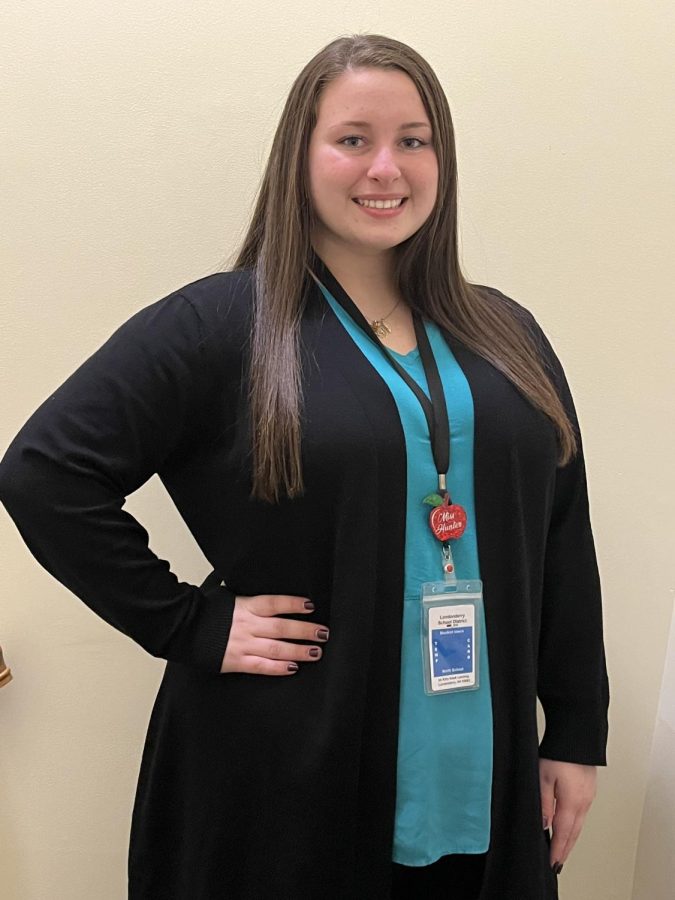The challenges of elementary education during a pandemic
Ashlee Locke-Hunter, ’22, posed in her typical student teacher attire
February 11, 2022
Oftentimes, when reflecting upon the pandemic, one may focus only on their own individual woes. The loss of a graduation, a close loved one, a long-term job. At large, Covid-19 has resulted in devastation towards healthcare, the economy, and the education system; particularly those classrooms designated for elementary learners.
Child development has been impacted greatly by the global pandemic due to psychological and academic trajectories that are often overlooked by those who don’t have any connection to the downfall of preschools and daycares. However, for the children, parents, and teachers, the adverse effects of the pandemic are overwhelming.
Student teacher Katie Doyle, ‘23, worked throughout the pandemic at Henniker community school with a class of 2nd graders. There, she acknowledged the presence of developmental delays on students displayed through the lack of attention and knowledge of what a school day would look like pre-pandemic. With younger grades, many students have never experienced the routine of an in person class. This in turn has led to difficulties in the ability to focus or comprehend what is being taught in a class setting.
Doyle stated that the effects of the pandemic specifically has resulted in, “needing to take a lot of breaks during the day. Which impacts how much time the students are learning in the classroom. Movement breaks often last up to five minutes and then trying to transition back to work is often a struggle. These breaks are needed multiple times throughout the day which will add up to a lot of unused time in the classroom.”
In addition to a decrease in learning hours held in a classroom, children are also not obtaining adequate social stimulation. Doyle acknowledged the difficulties of remote learning, especially with concerns over holding a student’s attention through a screen. She discussed how students are easily distracted and because a teacher is not in the physical space with them, teachers, such as herself, have to adapt their strategies in order to make sure that the students are interacting and learning to the highest ability.
Senior Ashlee Locke-Hunter furthers this concern of online learning, by explaining how, as a student teacher, she has witnessed the variation between academic competency start to vary more within an age group. “Academically, many students are at even more varied levels than in previous years due to the switching to remote learning the past two years. Some students do not get as much support and access to materials that are in the schools daily as well as full time teachers and aides in the room.” Locke-Hunter then specified that “In teaching math, I learned that we as teachers needed to go back to some foundational skills that are taught in the lower grades and would normally be a refresher this year, but we needed to teach those skills before moving into our grade level standards. This gap is no one’s fault but some subjects are harder to teach virtually due to the varied levels and limited time on the computer with students.”
There is ease in the focus of one’s own personal adversities in the face of a worldwide calamity, however, there is a necessity in accessing the long-term effects of any disaster. And in case of the Covid-19 pandemic, the future rests in the wellbeing of the children. Historical forces shape the social trajectories of family, education, and work, and they in turn influence behavior and particular lines of development. As Doyle and Locke-Hunter depicted, elementary age students are experiencing detrimental burdens in receiving their primary education. Even though children are seen to be less physically susceptible to Covid-19, relative to adults, they are at a significant developmental risk. Additional at-home stress including unemployment, isolation, and underlying anxieties regarding health, heighten the risk of negative impacts on a developing child. All of these risk factors are then painted with educational disruptions and discrepancies that heighten the concern for a child’s psychological well-being.
Doyle, in closing, stated if she could, she would tell “parents and teachers that being patient is so important right now. We don’t have control over what is going on in the world and all we can do is adapt to the current situation and do our best for the students. We all have bad and stressful days, teachers are people too and we have to make sure we are taking care of ourselves and our loved ones too.”



